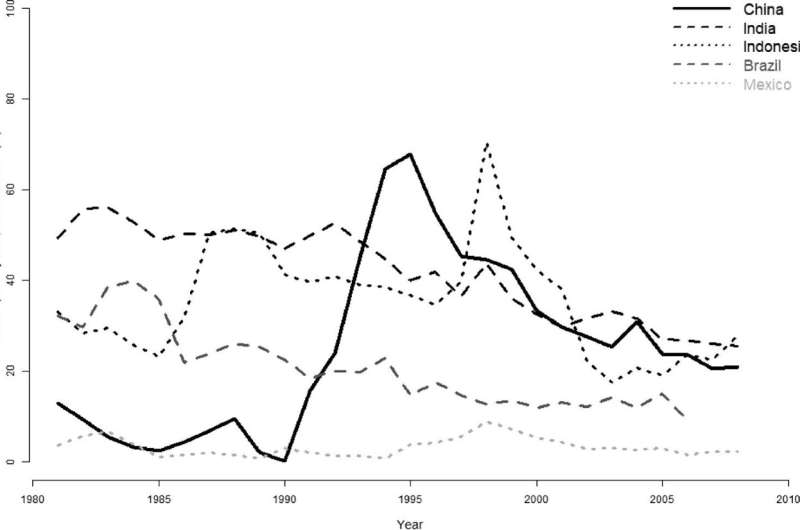This article has been reviewed according to Science X's editorial process and policies. Editors have highlighted the following attributes while ensuring the content's credibility:
fact-checked
trusted source
proofread
China's extreme poverty rate increased under capitalist reforms, study finds

It is widely believed that China's socialist economy had relatively high rates of extreme poverty, while the capitalist reforms of the 1980s and 1990s delivered rapid progress, with extreme poverty declining from 88% in 1981 to zero by 2018.
This belief has been challenged by a research project carried out by the Institute of Environmental Science and Technology of the Universitat Autònoma de Barcelona (ICTA-UAB) in collaboration with Macquarie University in Australia and Maastrich University in the Netherlands. The researchers point out that the data used to make these claims relies on the World Bank's extreme poverty line of $1.90 per day (2011 PPP). The findings are published in the journal New Political Economy.
However, the World Bank's method has come under sustained critique in recent years, as it does not account for the cost of meeting basic needs, which varies across countries and over time, even when measured in PPP terms.
To correct for this, researchers Jason Hickel of ICTA-UAB, Dylan Sullivan of Macquarie University and Michail Moatson of Maastricht University reviewed evidence on the share of the population unable to afford a basic subsistence basket—data which was recently published by the OECD.
The researchers show that from 1981 to 1990, when many of China's socialist provisioning systems were still in place, China's extreme poverty rate was only around 5.6%, substantially lower than in capitalist economies of comparable size and income at the time: 51% in India, 36.5% in Indonesia, and 29.5% in Brazil. This is because China's system of price controls and subsidies for food and housing kept the cost of basic needs low relative to economy-wide prices, and relative to working-class incomes.
The researchers found that China's relatively strong performance on basic-needs poverty during the socialist period is consistent with its performance on a range of social indicators, including life expectancy, infant mortality, death rate from malnutrition and poor sanitation, mean years of schooling, and access to electricity.
Moreover, researchers found that extreme poverty in China increased during the capitalist reforms of the 1990s, reaching a peak of 68 percent in 1995, as the privatization of China's public provisioning systems caused the price of essential goods to increase. While access to basic needs recovered during the 2000s, rough estimates for 2018 suggest that the extreme poverty rate remains at roughly the same level as during the 1980s.
The study's lead author, Sullivan, says, "This research has important implications for policymakers and the development sector. Our findings suggest that socialist policies of public provisioning, subsidies, and price controls can be effective at reducing or preventing extreme poverty. Meanwhile, market-based policies and privatization may threaten people's ability to meet basic needs."
This research also suggests that rapid economic growth and improvements in aggregate income—as important as these may be in many contexts—cannot be relied upon to reduce extreme poverty. China's experience during the 1990s suggests that economic growth may occur simultaneously with rising poverty under conditions of privatization and commodification.
According to Hickel, "when it comes to reducing extreme poverty in low-income countries, improving people's access to public services and social guarantees is at least as important as increasing productive capacity."
The authors point out that, according to the cost-of-basic-needs data they review, the world's governments failed to achieve the first Millenium Development Goal—i.e., to reduce by half the share of people in extreme poverty between 1990 and 2015. Moatsos said that "this represents a failure of global economic governance and suggests that new policy approaches are needed in order to eradicate extreme poverty for all people everywhere."
More information: Dylan Sullivan et al, Capitalist reforms and extreme poverty in China: unprecedented progress or income deflation?, New Political Economy (2023). DOI: 10.1080/13563467.2023.2217087
Provided by Autonomous University of Barcelona




















